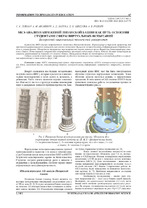| dc.contributor.author | Довнар, С. С. | |
| dc.contributor.author | Авсиевич, А. М. | |
| dc.contributor.author | Лапука, А. Д. | |
| dc.contributor.author | Шведова, Д. Н. | |
| dc.contributor.author | Роденя, А. В. | |
| dc.coverage.spatial | Минск | ru |
| dc.date.accessioned | 2022-06-28T12:58:12Z | |
| dc.date.available | 2022-06-28T12:58:12Z | |
| dc.date.issued | 2022 | |
| dc.identifier.citation | МКЭ-анализ напряжений пизанской башни как путь освоения студентами сферы виртуальных испытаний = Fea stress analysis of the tower of pisa as a way for students to explore the sphere of virtual testing / С. С. Довнар [и др.] // Системный анализ и прикладная информатика. – 2022. – № 2. – С. 67-75. | ru |
| dc.identifier.uri | https://rep.bntu.by/handle/data/113388 | |
| dc.description.abstract | Выполнена МКЭ-оценка напряженного состояния Пизанской башни. Виртуальные испытания проведены для проектного вертикального и реального наклонного состояний. Выявлено несовместность деформирования барабана колонн и ствола башни. Обнаружено двукратное перенапряжение колонн нижнего яруса. Выявлены концентраторы сжатия в башне. Концентрация напряжений сопровождает винтовой ход внутри ствола. Описан дуговой концентратор сжатия, возникающий на переходе от ствола к базису. Даны рекомендации по мониторингу системы. Собран методический опыт, позволяющий студентам полноценно участвовать в командной работе в серьезных виртуальных испытаниях в сфере CAE. | ru |
| dc.language.iso | ru | ru |
| dc.publisher | БНТУ | ru |
| dc.title | МКЭ-анализ напряжений пизанской башни как путь освоения студентами сферы виртуальных испытаний | ru |
| dc.title.alternative | Fea stress analysis of the tower of pisa as a way for students to explore the sphere of virtual testing | ru |
| dc.type | Article | ru |
| dc.identifier.doi | 10.21122/2309-4923-2022-2-67-75 | |
| local.description.annotation | FEA of stress state for Pisa Tower is accomplished. Imaginary vertical orientation of the tower is simulated as well as its actual leaning position too. Moderate deformational incompatibility between “column drum” and “stem” load-bearing systems is revealed. Twofold overstressing of lower colonnade is found comparatively to the stem surface. Tower’s compressive stress concentrators are described. The inner helical passage into stem causes a periodical stress concentration about 1.5 – 2 times in the passage vicinity. Arch compression concentrator tied to stem – basis transition is revealed. Places for priority monitoring of marble masonry are pointed out. Some methodic experience is gained due to lively and successful student participation in all phases of the Pisa Tower FEM simulation. | ru |

